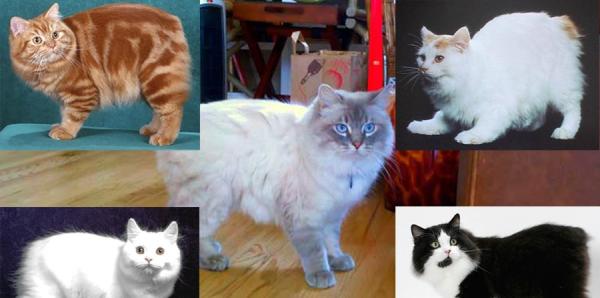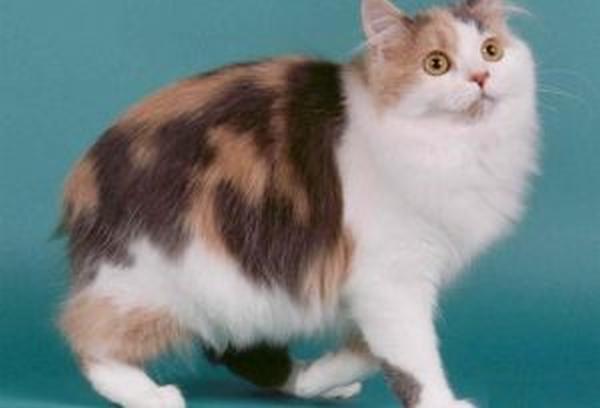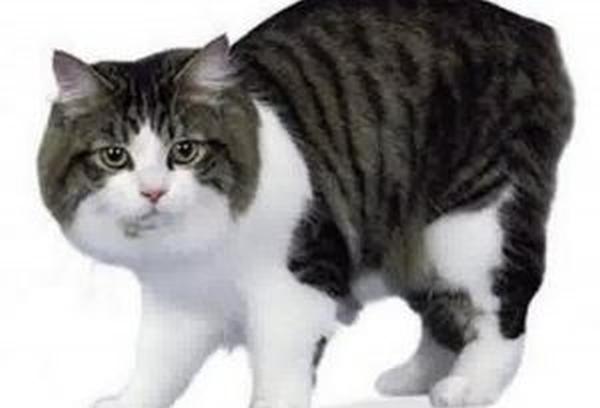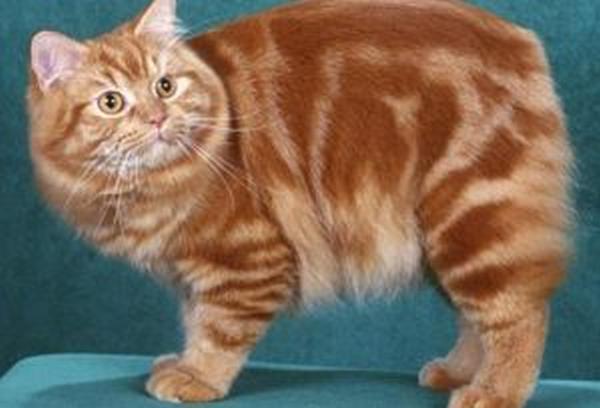Cymric cat: Breed Personality, Behavior Facts and Characteristics, Health Care Info

The cymric cat is a cat without a tail, its appearance in the feline world was the result of a casual and natural selection. It has the appearance of a stuffed ball, it is a solid cat of medium size, body and round head
Pictures of cymric cats
Here we show you the photos and images of the cat breed cymric



The cymric cat
The cymric cat has a rounded physical structure, the main feature is the lack of tail. The cymric come from a wide variety of cats with long tails.
The types of tail they have are in four groups: a quarter, more than a quarter, stump and long. The absence of tail is due to a dominant Manx gene; Cymric that have this gene will have one of the four types of tail.
The cats of tail fourth They do not have a line and they are very valuable in exhibition competitions. They have a dimple at the base of the spine, where the tail should be if it were there.
The cymric cats with more than a quarter of tail, they have a tail stump.
Cymric cats with tail stump, have a tail stump in the shape of a curve or twisted.
Those of long tail, they are cymric that have tails almost as long as those with long tails and are reared as pets.
What is the origin of cymric cats?
There are no exact sources to know the origin of the race, but in different theories its origin is associated to the Isle of Man in Ireland. For this it is necessary to review a little of its history through the years.
The history of the cymric cat
Some historians believe that the cymric cat was introduced by explorers to the Isle of Man, the Manx existed there for many centuries. The Isle of Man in the Irish Sea, between England and Ireland, does not possess an endogenous cat breed.
There are several theories about the introduction of cats to the Isle of Man. These indicate that they arrived with the Spanish army, with the Phoenician merchants or with Viking settlers. Many believe that the British shorthair cat was one of the breeds that mixed with the Manx. By the similarity in the shape of the body.
Some records describe the cymric as a mutation among domestic cats on the island. In which case, the lack of tail is dominated by a dominant gene, unlike short-tailed breeds. This would indicate that the Manx and the Cymric (KIM-ric) are not related to races like the Japanese Bobtail because their tails are governed by recessive genes.
This breed became very popular in the early days of cat fashion, Manx cats have very old records of America too.
The cymric cat, apparently, has been at the same time as the Manx. The Cymric according to his followers is not a hybrid made by man, between crosses of Manx and Persian cats, but by variations of the Manx race. On the Isle of Man there were cats with short hair and long hair. It is believed that the long hair gene passed through them, just like the Manx gene. The long hair gene is recessive and could be inadvertently carried through the generations of Manx.
The appearance of the cymric cat in championships
The Cymric breed is a longer manx cat, both have no tail. Its appearance in the feline world was not a consequence of human manipulation, it is a natural and fortuitous fact. Manx litters were born from time to time long-mantled offspring, which with the proper selection originated the cymric breed.
In 1963 the cymric was shown in the ACA, this race had no boom until 1970. Initially it was presented as Longhaired manx, the name was changed to Cymric.
For 1976, the CCA was the first association to accept the Cymric for championships.
In May of 1994, the CFA changed the name of Cymric to Manx with long hair, however, longhaired cats born of Manx parents can be registered as Cymric in all associations except CFF.
After a careful selection the cymric cat breed was born. Being the breeders Blair Wright of Canada and Leslie Falteisek of the United States, the people in charge of the race until they obtained their official recognition. The approval was only granted by the CFA, in Britain the cymric is not yet registered as a race.
Finally, Cymric and Manx are two of the most difficult breeds to breed due to the Manx gene; They bring with them genetic problems that are minimized with careful crossing. Cymric embryos that are homozygous die in the uterus, comprise almost a quarter of the litter; so Cymric litters are small. Heterozygotes can have deformities such as spina bifida, fused spine and colon defects.
What are the most common characteristics of the cymric cat?
Cymric cats have a rounded structure, which is very salient in them.
The head of the cymric is round, with prominent cheeks. It is of medium size with inclination of the forehead to the nose, developed snout; defined chin, well-defined whiskers.
The ears of the cymric cat are medium sized, broad at the base and narrow at the tip.
The cymric have medium to large eyes, placed at a slight angle to the nose, their color depends on the coat they have. You can wear eyes in dark blue, bright copper or one of each color.
Depending on the tail there are 3 varieties of Cymric: the Rumpy that has no tail and only has a hole in its base; the Stumpy that has only a few vertebrae of them; and the Longy, with a tail a little shorter than in the rest of the races. In the competitions only the variety Rumpy is exhibited
Regarding its fur, the double layer is of medium size, soft, silky, bright, dense and well placed. From the shoulders to the rooms, the fur under the abdomen and neck is longer than the rest of the body. In the cheekbones the coat is thick and full; The fur of the neck extends from the shoulders around the chest. It has streamers on the legs and ears.
Among the colors of the race are acceptable those that indicate that it is not a hybrid in the colors chocolate, lavender, Himalayan pattern or combinations with white
How is the behavior of a cymric cat?
Cymric cats are intelligent, friendly, playful, sociable cats, because they get along well with other pets and even visitors. They are very loyal to their humans and love to spend time with them. They can be taught several tricks easily. Even with their playful nature, they are not aggressive if they are not playful, so they have fun with children.
The race of cymric cats are powerful jumpers, so they will reach the highest shelves. For their past living on an island surrounded by water, they are fascinated by water as long as you do not put them there.
His curiosity is very great, because the cymric cat can even put his physical integrity in danger for it. It is also very serene which makes it perfect company.
Another peculiarity is that they communicate with silent and confidential meows because they are less vocalizers than other races.
How much does a cymric cat live?
A cymric cat has a life expectancy of between 12 to 15 years.
How can you get the confidence of a cymric cat?
To have the confidence of a cymric cat, you must educate it from puppy, so you will have a good companion. Treat him and feed him well, because he is a very loyal cat, if he receives the proper care he will be very fond of his owner.
What do you need to know to take good care of your cymric cat?
It does not take much to keep well cared for, only basic care like any cat breed.
To have your cymric kitten very well taken care of, you will have to give him one or two brushes per week, to take care of his coat and avoid swallowing his hair and forming hairballs.
Must give enough physical activities and constant games.
A good diet is very necessary for the cat cymric, as well as having the vaccines in order and a lot of love. Your cat will thank you with all your affection and company.
How to clean a cymric cat?
To clean your cat well cymric takes into account the following tips:
Brushing is very important for the health of the coat and the health of the cat. Give him one two weekly brushes to remove all the dead hair, you can use a furminator to brush your cat.
Trim your cat’s nails to take care of the health of your paws and avoid damaging your furniture.
In case your cat gets too dirty you should bathe it completely.
How to bathe a cymric cat?
This cat breed lived near the water in its origins, so they love to play with water, however, it is a little different with taking baths.
First, prepare all the necessary supplies to bathe your kitten, you will need shampoo for cats, plastic jugs, towels and warm water. You can use the sink to bathe your kitten. We recommend trimming your nails to avoid scratching you during the bath.
You should accustom your cat to start getting wet, better if it is from puppy, you can put warm water in the sink and put your cat standing. Let him get used to feel water between his legs and belly. Once you are calm with this, wet it gently with water, help yourself with a jug, avoid wetting your face and ears.
Put shampoo and massage your fur until it forms foam and start cleaning your cat. Then pour more water and rinse your cat. Then dry it and wrap it in a towel to rub and dry it.
You can trim nails after the bath.
How to clean the litter box of your cymric cat?
To have online hygiene you should clean the litter box partially once a day and once a week completely.
To clean the litter box daily you must remove all the solids that are in the box, solid of urine and feces. Help yourself with a plastic shovel, before you put on gloves and a mask to avoid infection with toxoplasmosis. Place the solids in a garbage bag and discard them.
When you touch clean the sandbox weekly, you must remove all the sand in a plastic bag. Do not forget to wear gloves and chinstrap. Then you should wash the litter box well, do not use scented detergent, dry the box and place cat litter.
Use sand that your cat likes, do not use sand with aromas, because many cats do not like it. If you want you can place a layer of baking soda at the bottom of the box, before filling the box with sand, so that the bad smell is absorbed.
Where do you have to locate the litter box of your cymric kitten?
You have to place the sandbox in a quiet place. Far from the path of people, it must be a private place without noise.
Do not place it behind the doors, if possible do not leave the box in the laundry room.
What do cymric cats eat?
No special diet is required for cymric cats. Give cat food constantly in their respective schedules.
You have dry, moist and natural food for cats. Try to supplement using all three types of food to have a balanced diet. Dry food is more recommended. If you want to offer natural food, you must give it meat, fish and cooked viscera.
How to train a cymric cat?
They are very intelligent so they will not take long to learn new tricks.
Teach him to give his leg by offering rewards for it. Play with your cat, like challenging games, give him balls of wool, toys for cats. One very good exercise is to use the laser pointer, but do not abuse because you can frustrate it and good not like the game.
When our feline starts scratching the furniture, not using his litter box or scratching, we must pay close attention. To avoid scratching our furniture, give it a scraper that you can buy or make by hand. If you do not use your litter box and start doing your things elsewhere, place aromas of lemon, lavender or mint to keep the cat away from that place. If you scratch it is possible that you are seeing it as a toy, use it to play with your toys and not with your hands.
What disease can cymric cats have?
The cymric cat can present a single disease of the breed, due to the absence of the tail, the bifid tail can be present.
In addition to it, they can have the most common diseases that any cat can suffer such as:
- Allergies
- Bronchopneumonia
- Cataract
- Conjunctivitis
- Flu
- Otitis
- Gastrointestinal problems
- Hair balls
How to keep a cymric cat healthy?
To keep a cymric cat healthy, take good care of it. A good diet is very necessary for the cat cymric, as well as having the vaccines in order and a lot of love.
What is the price of a cymric cat?
A cymric cat can be priced between 200 dollars when you buy it in a pet house or a private one, if you buy it with a breeder you can ask for up to 500 dollars.
Where to buy a cymric cat?
We recommend buying a cat of the cymric breed for sale with a breeder, so you can be sure that you buy a cat of breed with its pedigree.


